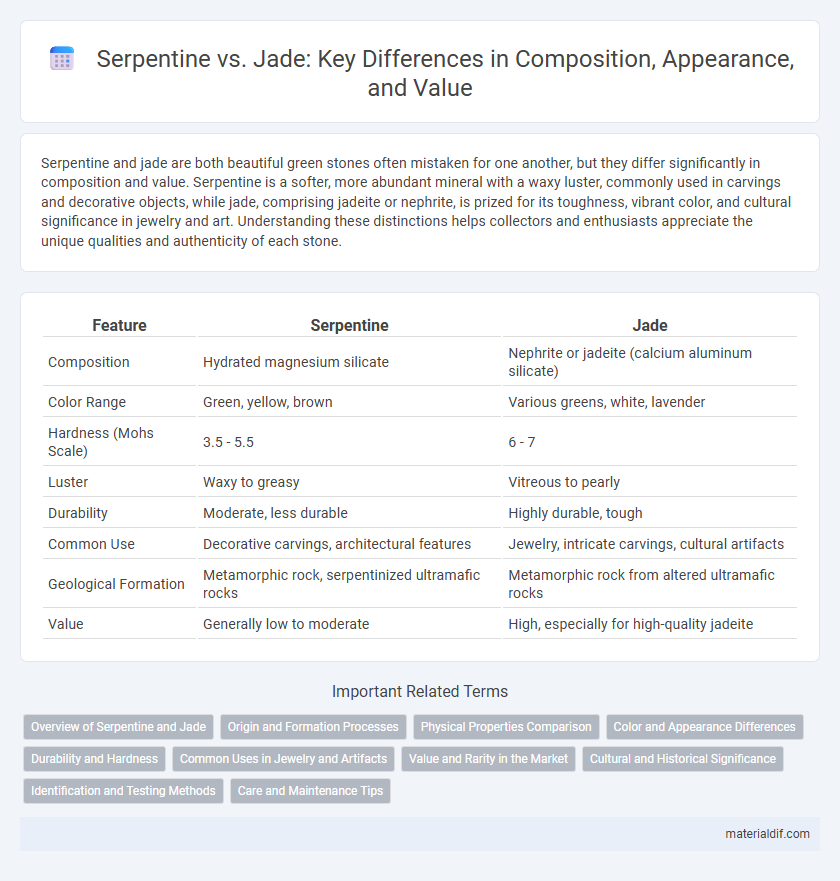Serpentine and jade are both beautiful green stones often mistaken for one another, but they differ significantly in composition and value. Serpentine is a softer, more abundant mineral with a waxy luster, commonly used in carvings and decorative objects, while jade, comprising jadeite or nephrite, is prized for its toughness, vibrant color, and cultural significance in jewelry and art. Understanding these distinctions helps collectors and enthusiasts appreciate the unique qualities and authenticity of each stone.
Table of Comparison
| Feature | Serpentine | Jade |
|---|---|---|
| Composition | Hydrated magnesium silicate | Nephrite or jadeite (calcium aluminum silicate) |
| Color Range | Green, yellow, brown | Various greens, white, lavender |
| Hardness (Mohs Scale) | 3.5 - 5.5 | 6 - 7 |
| Luster | Waxy to greasy | Vitreous to pearly |
| Durability | Moderate, less durable | Highly durable, tough |
| Common Use | Decorative carvings, architectural features | Jewelry, intricate carvings, cultural artifacts |
| Geological Formation | Metamorphic rock, serpentinized ultramafic rocks | Metamorphic rock from altered ultramafic rocks |
| Value | Generally low to moderate | High, especially for high-quality jadeite |
Overview of Serpentine and Jade
Serpentine is a group of green to yellowish-green minerals known for its smooth, waxy texture and often used as a decorative stone or for carving. Jade refers to two distinct minerals, nephrite and jadeite, both prized for their toughness and vibrant green hues, commonly used in jewelry and cultural artifacts. While serpentine is softer and more abundant, jade is significantly harder and valued for its durability and rich color variations.
Origin and Formation Processes
Serpentine forms primarily through the alteration of ultramafic rocks such as peridotite during low-temperature, hydrothermal metamorphism, commonly found in subduction zones and ophiolite complexes. Jade consists of two distinct minerals: nephrite, a calcium-rich amphibole formed under regional metamorphic conditions, and jadeite, a sodium-rich pyroxene created in high-pressure, low-temperature environments associated with subduction zones. Both stones originate from complex geological processes, but serpentine's formation involves serpentinization reactions, while jade's formation depends on regional metamorphism and specific pressure-temperature conditions.
Physical Properties Comparison
Serpentine and jade differ significantly in physical properties, with serpentine exhibiting a Mohs hardness of 2.5 to 5, making it softer and more prone to scratching compared to jade's hardness of 6 to 7. Jade, primarily composed of either jadeite or nephrite, possesses a denser structure and higher toughness, allowing it to withstand impact better than the more brittle serpentine. The distinct color range and luster are also defining factors, as both stones display varying shades of green but jade tends to have a more vivid, translucent appearance, whereas serpentine often appears waxy or greasy.
Color and Appearance Differences
Serpentine typically exhibits a range of green hues from olive to deep forest green, often with a waxy or greasy luster and occasionally mottled or spotted textures. Jade, especially jadeite, displays more vibrant and translucent emerald or apple green shades, known for its smooth, glassy surface and fine-grained structure. The color intensity and translucency differences are key identifiers, with jade prized for its high polish and serpentine for its more matte or dull finish.
Durability and Hardness
Serpentine typically rates between 2.5 and 4.5 on the Mohs hardness scale, making it softer and less durable compared to jade, which ranges from 6 to 7. Jade, particularly jadeite, is highly valued for its toughness and resistance to chipping, making it suitable for intricate carvings and jewelry. The superior hardness of jade results in better longevity and scratch resistance, whereas serpentine's lower hardness requires more careful handling to avoid damage.
Common Uses in Jewelry and Artifacts
Serpentine is often used in ornamental carvings, beads, and cabochons due to its softness and ease of sculpting, making it ideal for intricate jewelry and decorative artifacts. Jade, prized for its toughness and vibrant green hues, is traditionally used in high-value jewelry, ceremonial objects, and intricate carvings symbolizing cultural significance, especially in East Asia. Both stones are valued in art and jewelry but serve different aesthetic and functional purposes based on their physical properties and cultural meanings.
Value and Rarity in the Market
Serpentine, often green and smooth, is valued lower than jade due to its abundance and softer composition. Jade, especially jadeite, commands a higher market price driven by its rarity, durability, and cultural significance in East Asia. The rarity of high-quality jade with vibrant color and translucency significantly increases its value compared to more common serpentine stones.
Cultural and Historical Significance
Serpentine and jade both hold deep cultural and historical significance, with jade revered in Chinese civilization as a symbol of purity, harmony, and status for over 7,000 years. Serpentine, often mistaken for jade, has been used in Mesoamerican cultures for ritualistic objects and protective amulets due to its association with earth and healing energies. While jade's toughness made it a prized material for intricate carvings and ceremonial tools, serpentine's relative softness facilitated symbolic and decorative uses across various ancient societies.
Identification and Testing Methods
Serpentine and jade can be distinguished by their hardness and luster; serpentine typically registers 2.5 to 5.5 on the Mohs hardness scale, while jade ranges between 6 and 7, making jade significantly harder. Conducting a scratch test, serpentine scratches easily with a steel blade, whereas jade resists scratching and maintains a waxy, smooth surface. Advanced identification methods include spectroscopic analysis and specific gravity measurement, with jade exhibiting a higher density (around 3.3 g/cm3) than serpentine (approximately 2.5 to 2.6 g/cm3).
Care and Maintenance Tips
Serpentine requires gentle cleaning with mild soap and warm water, avoiding harsh chemicals that may damage its softer surface, while jade demands regular cleansing with a soft cloth and occasional application of mineral oil to maintain its luster. Both stones benefit from storing in padded pouches to prevent scratches and should be kept away from extreme temperatures to avoid cracking. Proper care ensures the longevity and vibrant appearance of serpentine and jade jewelry.
Serpentine vs Jade Infographic

 materialdif.com
materialdif.com